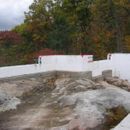What material should I use to fill the footprint of my new home ?
As seen in the attached photograph the new home (near Brockville, Ontario, Canada) is being built 100% on granite bedrock. The site slopes to the west . That is the right-hand side of the photograph. There are two drains (4″ diameter) located on the footings on the west side.
The home will have a 4″ concrete slab on 2″ of rigid insulation (taped). This will sit on the fill. At the east and north sides of the homes, the fill will be perhaps 1 foot thick. At the west side, the fill will be perhaps 4 feet thick.
My concern is that water will enter the footprint and saturate the fill. The fill could freeze during the winter and heave the concrete slab. This could happen during the building process before there the walls and the roof are covering the fill.
I presume that the fill should permit easy drainage of the water to the two 4″ drains on the west side. Should I use Granular “A”(with fines), Granular “B”(with fines), sand, 3/4” clear gravel (no fines), or some combination?
GBA Detail Library
A collection of one thousand construction details organized by climate and house part










Replies
Wilder,
Do you have a contractor, or are you the GC? If I were you, I would talk to local excavators, foundation contractors, and the dispatcher at the local gravel quarry.
The names used for different types of gravel and stone vary regionally. If you want good drainage, it's hard to beat what we call 3/4-inch crushed stone -- that's the local term in my part of Vermont. But I don't think the inclusion of fines matters much. The fines allow for better compaction -- assuming you are running a plate compactor.
Anyone else want to chime in?
No fines and larger stone drains.
Wilder,
Like Martin said, I think it depends on how compacted you want the fill...
Given that the depth of the fill varies so much around your footprint, I would guess that you'd want to compact your fill in shallow lifts to help avoid differential settlement after placement of the concrete.
I am building my house on top of a pad of compacted Granular A between 12 and 18 inches thick.
I put 4" weeping tile under the gravel and the pad drained very quickly even after reaching maximum compaction.
If you include some extra weeping tile under the fill, would it be possible to tie it into the footing drains?
You'll want to make sure that whatever fill material gets used, the low spots within the footings are able drain freely, or else you'll always have a "sump" under your slab.
Martin, yes, I am the general contractor (first home) and home owner.
The structural engineer tells me that the fill should be Granular 'A' (with fines). As Lucas has mentioned, the Granular 'A' (with fines) would be compacted. In our case at every 10 inches.
The geotechnical engineer tells us that the fill should be Clear 3/4” gravel (no fines). I think that is in line with the comment from AJ. I have been told that Clear 3/4” gravel will not compact but we would do that nevertheless.
One of the suppliers of gravel tells us that it should be Granular 'B' (with fines) for the deep parts and then Granular 'A' (with fines) for the rest; all of it compacted.
The article “Vapor Barriers, Radon, Basement Slabs, and VOCs — How to Stop the Poison?” posted on Nov 1, 2010 on the GBA site has a diagram/schematic. The schematic makes specific reference to “Stone Pad (No Fines)” as the material upon which rests the concrete slab.
However, there are other articles that make reference to “granular” which I presume means “gravel with fines”.
Lucas, you make reference to “Granular A”. Was that with or without “fines”?
Wilder,
The granular A I used included fines - it's the same material that's used as a substrate for paved roads and highways.
I think you are right to be concerned about having your fill saturated with water.
But addressing this concern, I think, has less to do with the choice of fill material and more to do with giving bulk water a place to go.
Any depressions in the bedrock that can't drain will collect ground water like a sump - like a french drain with no drain.
If you're interested here is a link to my blog which shows the construction of the gravel pad.
There were a few complications during the process that you might find interesting.
http://ourhouseuponmoosehill.blogspot.ca/2011/06/excavation-and-compaction.html
When I build clay tennis courts, material with fines holds water, without lets it drain away. With fines can be compacted into a very dense layer. Without you need the sides of your filled area to trap the stone. The stone does not compact. Where I live a trench that is deeper than frost can be filled with large similar sized stone without fines and used to support a surface level slab.
Most of this all depends on the engineer involved and what they are familiar with.
Cellar slabs here if built over stone use 3/4-1 1/2" stone and no fines.
Hello all. We (structural engineer, excavator, dispatcher) concluded our discussions and selected 7/8" without fines. The installation/compaction was done in early December (see attached photo). Thank you all for your input.